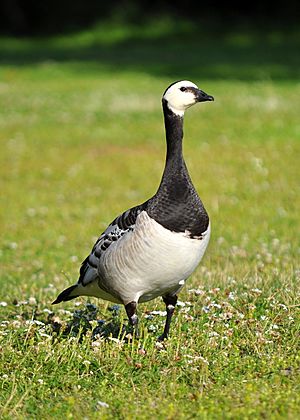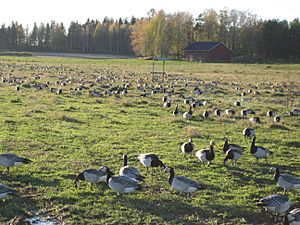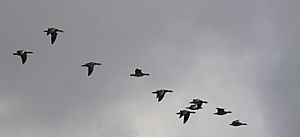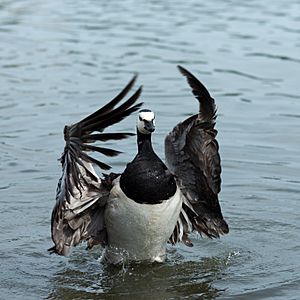Barnacle goose facts for kids
Quick facts for kids Barnacle Goose |
|
|---|---|
 |
|
| Conservation status | |
| Scientific classification | |
| Kingdom: | |
| Phylum: | |
| Class: | |
| Order: | |
| Family: | |
| Subfamily: |
Anserinae
|
| Tribe: | |
| Genus: | |
| Species: |
B. leucopsis
|
| Binomial name | |
| Branta leucopsis (Bechstein, 1803)
|
|
The Barnacle Goose (Branta leucopsis) is a type of black goose. It belongs to the Branta group of geese. These geese usually have mostly black feathers. This helps tell them apart from the grey geese in the Anser group.
Contents
What Does a Barnacle Goose Look Like?
The Barnacle Goose is a medium-sized bird. It is about 55 to 70 centimeters (22 to 28 inches) long. Its wings can spread out to 130 to 145 centimeters (51 to 57 inches). An adult goose weighs about 1.2 to 2.2 kilograms (2.6 to 4.9 pounds).
This goose has a white face. Its head, neck, and upper chest are black. Its belly is white. The wings and back are silver-gray. They have black-and-white stripes that look shiny in the light. When the goose flies, you can see a white V-shape on its back near the tail. You can also see the silver-gray color under its wings.
Where Do Barnacle Geese Live and Travel?
Barnacle geese mostly breed on the Arctic islands. These islands are found in the North Atlantic. There are three main groups of these geese. Each group has its own breeding and wintering areas.
- One group breeds in eastern Greenland. They spend the winter on the Hebrides islands in western Scotland and in western Ireland. There are about 40,000 geese in this group.
- Another group breeds on Svalbard. They winter at the Solway Firth, which is on the border between England and Scotland. This group has about 24,000 geese.
- A third group breeds on Novaya Zemlya. They spend the winter in the Netherlands. This is the largest group, with about 130,000 geese.
Since 1975, a new group has started. These geese came from the Novaya Zemlya group. They now breed on islands and coasts in the Baltic Sea. This includes countries like Estonia, Finland, Denmark, and Sweden. They also winter in the Netherlands. This newer group has about 8,000 geese.
Sometimes, you might see Barnacle Geese in other parts of northern Europe. These are often birds that have escaped from zoos or bird collections.
How Do Barnacle Geese Live?

Barnacle geese often build their nests high up on mountain cliffs. This helps keep their eggs and young safe from predators. Predators are animals that hunt them, like Arctic foxes and polar bears. But being high up also means they are far from food.
Like all geese, the adult Barnacle Geese do not bring food to their babies. Instead, the young goslings must get to the ground to find food. When they are only about three days old, the goslings jump off the high cliffs. They cannot fly yet. Their small size, soft feathers, and light weight help protect them. Some goslings get hurt or die when they hit the rocks below. Arctic foxes often wait below. They catch goslings that are injured or have died from the fall. The foxes also try to catch the young geese as their parents lead them to places with food, like wetlands.
Protecting Barnacle Geese

The Barnacle Goose is a bird that is part of an agreement. This agreement is called the Agreement on the Conservation of African-Eurasian Migratory Waterbirds (AEWA). It helps protect birds that travel long distances.
Barnacle geese started breeding in Sweden in 1971. For many years, the entire population of Barnacle Geese would leave in the autumn. They would then return in the spring. This happened soon after they began breeding in the wild.
Barnacle Goose in Old Stories
For a long time, there was a strange story about how Barnacle Geese were born. People believed they grew from driftwood found in the sea.
An old story said: "These birds are born in a very strange way. They are like marsh geese but a bit smaller. They come from fir wood that floats in the sea. At first, they look like a sticky substance. Then, they hang by their beaks from the wood, like seaweed. They are covered in shells as they grow. After some time, they get strong feathers. Then they either fall into the water or fly away. They got their food from the wood's sap or from the sea. This was a secret and amazing way of getting food. I have often seen more than a thousand of these small birds. They were hanging from one piece of wood on the seashore, inside their shells, already formed. They do not lay eggs like other birds. They also do not hatch any eggs. They do not seem to build nests anywhere on Earth."
This story was told in many old books. But some writers, like Albertus Magnus, said it was not true.
This belief might have come from the fact that people never saw these geese in summer. They thought the geese were growing underwater. In reality, the geese were breeding in faraway Arctic places. The name "barnacle" for the sea creatures might have come from this old story.
Images for kids
-
Barnacle Geese during their autumn migration in Sweden.
See also
 In Spanish: Barnacla cariblanca para niños
In Spanish: Barnacla cariblanca para niños








